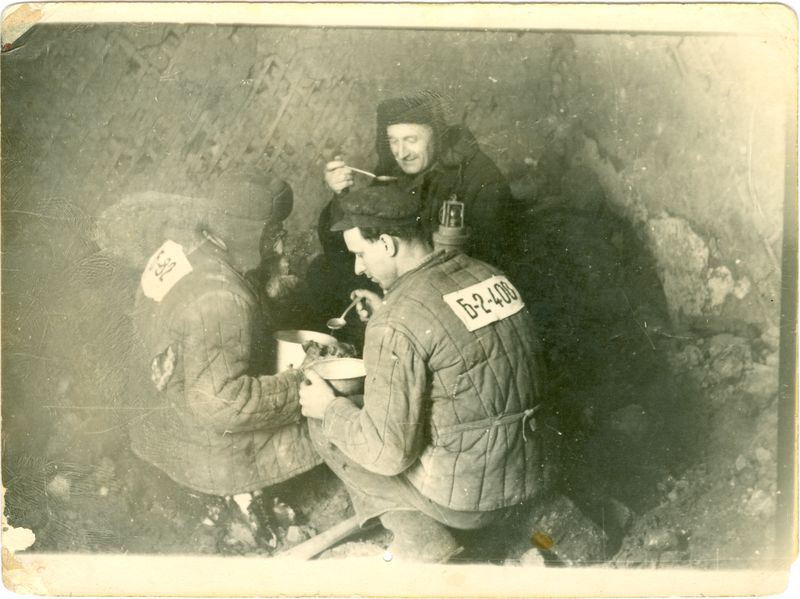While I was reading Julius Margolin’s account of his five years in Soviet slave labor camps, I attended, remotely, a lecture by Angela Davis, who had been invited by a Northwestern student group that treated her as a secular saint. Davis, I knew, had twice been the vice-presidential candidate of the American Communist party, which was directly controlled by Moscow. In 1979, six years after the publication of Aleksandr Solzhenitsyn’s Gulag Archipelago, she accepted a Lenin Peace Prize from the Soviet government. She also supported Erich Honecker’s East Germany and praised the Berlin Wall (in East German parlance, the Anti-Fascist Protective Wall). Despite everything we know about Soviet slave-labor camps causing the deaths of millions, as well as Soviet genocide of numerous ethnic groups, she has remained unrepentant and unreflective about her support for the USSR.
Margolin’s memoirs—written in Russian in 1946 and 1947 and recently published in English as Journey into the Land of the Zeks and Back—pose a deliberate challenge to the pro-Soviet apologetics of Angela Davis and likeminded progressives. Ably translated by Stefani Hoffman, the new volume includes helpful introductions by Timothy Snyder and Katherine R. Jollock that describe the work’s publication history, provide necessary background information, and underscore what is most significant in the book. It begins with the outbreak of World War II in September 1939, follows the author’s journey to the gulag—whose inmates were colloquially called zeks, hence the title—and ends with in September 1946, on a boat bound for the Land of Israel.
Iulii Borisovich Margolin was born in 1900 in Pinsk, then part of tsarist Russia’s Pale of Settlement. Educated in Russian, he also spoke Polish and Yiddish as native languages. Having become a Zionist after receiving a doctorate in philosophy in Berlin, he published The Idea of Zionism (in Polish) and a book on the philosophy of poetry (in Yiddish). Margolin and his family moved to Palestine in 1926, but he commuted to work in Poland for three years. In the summer of 1939, on a business trip to Poland, he was trapped there when, as a result of the Molotov-Ribbentrop pact of August 23, 1939, Hitler and Stalin divided up the Polish state.
All efforts to return to Palestine failed. Like refugees from German-occupied Poland who found themselves in the Soviet zone, Margolin was given the choice of accepting Soviet citizenship or relocating to German-controlled areas. It says a great deal about the Sovietization of eastern Poland—and Stalin’s reputation—that numerous Jews, in his words, “agreed to return to the German yoke and wear the yellow patch.” Margolin could not understand why the Soviets did not allow him to go home. “Not a misunderstanding or a temporary delay was holding me back,” he explains. “I was like a fly who has landed on a sticky leaf with the inscription ‘Death to the flies.’”
In fact, hundreds of thousands of Polish citizens were sent to Soviet labor camps, as were citizens of the Baltic republics when they were forcibly incorporated into the USSR in the following year. Margolin was eventually given a five-year term not for any crime but for being “a socially dangerous element.” If that seems odd, he recounts the story of a nurse he met who became a zek simply because her father came from Latvia; she was eight years old at the time. Things were especially bad for Jews during the two-year alliance with Hitler, when the Soviet government constantly praised the Nazi regime and its policies. Criticism of the Third Reich was forbidden.
After the Germans invaded the USSR, there were two occasions when Polish prisoners were amnestied to serve in Polish armed forces. Margolin was not included in the first amnesty because, Soviet officials ruled, he was Jewish, and missed the second because his health had so deteriorated that he could not be a soldier. Twice, in fact, he was on the verge of death from malnutrition, his weight having declined from 176 to 99 pounds.
In Margolin’s view, Westerners who apologize for the Soviet Union, or who do not care to know what happens there, are justifying “slavery in a new form”—new because it was much worse than slavery as we usually think of it. Quite literally, people were of less value than animals, since mass arrests made it easy to replace those who died at the camps, while farm animals were harder to obtain. “The forage-cutter worked on horsepower,” he remarks matter-of-factly, “but there was no horse. Instead of a horse they utilized a writer.”
In his well-known memoirs, Dmitri Panin, the model for a character in Solzhenitsyn’s novel In the First Circle, muses that it would have been far better to be a slave under Pharaoh. In Egypt, after all, you would not be working at 70 degrees below zero, as in Kolyma or Vorkuta, and would have been fed enough calories to sustain life. “Since a slave had market value,” Panin wrote, “he warranted some care and attention, instead of being regarded as an enemy who had to be destroyed.” And as we know from the biblical account, Hebrew slaves, unlike Soviet ones, grew in number. Margolin met a Jewish prisoner who had been in Dachau before the war and preferred it. (Although, it should be noted, the Nazis had not yet begun systematic murder during his time in the German camp.)
There is no Communism without slavery, Margolin insists. In this judgment, he agrees with Trotsky, Lenin, and other early Bolsheviks who reasoned that a perfectly planned economy, having abolished market mechanisms and incentives, as happened during the Russian Civil War, should rely on coercion as the only possible alternative. According to Trotsky’s plan, soldiers released from the army were immediately drafted into labor battalions with no choice of jobs. Lateness, sluggish work, or other minor infringements were subject to court martial or execution for desertion. “What except . . . complete economic anarchy could be the result of the stupid attempt to reconcile bourgeois freedom of labor with proletarian socialization of the means of production?” Trotsky asked, while Lenin, five months after the Bolshevik takeover, demanded that the party “begin introducing compulsory labor service immediately.” What’s more, he continued, we must “require the use of compulsion”—that is, compulsion was compulsory—“so that the slogan of the dictatorship of the proletariat shall not be desecrated.”
The complete failure of these attempts to introduce Communism in the years immediately following the Revolution led to mass famine, leaving millions dead, and eventually to a looser New Economic Policy that restored some market activity. But when Stalin resumed the push toward Communism in the late 1920s, workers in the workers’ paradise were again sent to labor camps for minor infringements. Even outside the camps, then, something as close as possible to slavery obtained. As Margolin observes, it was much easier to divorce one’s spouse than to leave one’s job.
A significant portion of the planned economy’s output was produced, or supposed to be produced, by the camps, which, some Soviet theoreticians argued, were a model for the future of society as a whole. If fear of being sent to the camps spurred work in the civilian economy, the main agent of coercion in the camps was hunger. Every camp memoir I know stresses a diet lacking the calories to sustain life and the effect of persistent malnutrition on those who managed to survive for a few years. Margolin is particularly eloquent on this topic.
Reflecting on a story he had heard before imprisonment about sex-starved prisoners in a Western country carving pieces of bread into the shape of female genitalia, he realized that these prisoners could not have been particularly hungry to waste bread like that. As for Knut Hamsun’s novel Hunger (1890), in which an impoverished writer wanders through Norway’s capital city, Margolin remarks, “This is so ridiculous, so literary. What kind of hunger can there be in a city where everyone is satiated . . . and the shop windows are full of every good thing?” After all, “every garbage heap contains so much that is edible, just bend down,” and at the market people step on food. By contrast, starved zeks would fight over rotting herring heads that even pigs would not touch.
“When the body is broken,” Margolin explains, “food provides the sole sexual pleasure. Hunger quickly brought us to a state where we artificially began to drag out the process of eating,” from five minutes to an hour or more. It was hard to look at the “elderly lasciviousness” of one zek, with his “moist, sensuous lips” and “eyes shrouded with a senseless fog.” Having at last finished eating he would “sit for a while overwhelmed, with a look of sorrowful astonishment on his thin, bony face.”
All prisoners experienced “hunger dreams.” Every night “one dreams of food in all its forms and variations. . . . All these dreams inevitably ended in catastrophe. No matter how many times I gathered handfuls of food, not once did I succeed in tasting it.” As starvation progresses, however, these dreams disappear as pure indifference sets in. “A hungry dream means that something in us is [still] rebelling, longing, twitching, striving for satisfaction. People dying from alimentary dystrophy, however, no longer have hungry dreams. They lie quietly.” “Alimentary dystrophy” was the prescribed euphemism for starvation, until it appeared so often in death records that the authorities banned it. As a result, Margolin drily remarks, “starting in May 1945, not one more person died from starvation in Soviet imprisonment.”
Hunger contributed to a process Margolin calls “dehumanization.” So did being assigned to work one simply could not do, often suffering humiliation in the company of those who could. Having lost all sense of self-worth, zeks no longer thought of themselves as anything but beasts. Their past life vanished from memory, they forgot words, and their time horizon shrunk to days or less. “The time comes when a person hates himself, hates everything that constitutes his essence. . . . He forgets what he did yesterday. . . . He differs from the beast only in that he can be used in a wider variety of ways.”
Zeks also lost their moral sense, stole from anyone weaker, and cared for nothing but their own need for food. Secular intellectuals, who had been convinced that ethics did not require belief in anything divine or sacred, lost their morals the fastest. Like so many other memoirists, including dedicated atheists like Evgeniya Ginzburg, Margolin reports that the only exceptions were the religious. They, and perhaps they alone, retained a sense of decency and of moral boundaries they would not cross. “Fanatic Christian martyrs,” as Margolin calls them, would refuse to work on Sunday, and ḥasidic Jews on Yom Kippur. So far as preserving a moral sense was concerned, it did not seem to matter what religion one adhered to.
When Margolin was at last released, he resolved to tell the world what he had seen. “Now I held a pen in my hand as if it were a flagpole,” he writes. The problem was that no one would pay attention.
“I must warm you,” cautioned an educated passenger he met on the ship taking him to Palestine, “that no one in our country is ready to accept such things. . . . You attacked Communism and therefore your truth has no meaning for them.” Margolin resolved to publicize the fate of a Jewish doctor who saved his life, but the doctor’s own family turned out to be Communists who insisted that only fascists claim there are slave labor camps in the Soviet Union. The same reaction greeted his attempts over the years to publicize the conditions of Soviet Jews, well before Elie Wiesel and American activists made their fate a cause célèbre.
These reactions were not limited to Palestine. Despite help from the anti-Communist writer Arthur Koestler, Margolin could not get his book published in the English-speaking world. A brief excerpt appeared in French, and in New York the Chekhov publishing house released a severely abridged Russian edition in 1952. The first complete edition, a French translation, did not appear until 2010. If many of Margolin’s descriptions seem familiar to those who have read The Gulag Archipelago (first published in 1973) or other camp memoirs, that is because, although his account preceded them, right-thinking people prevented the book from appearing.
Some have argued, Margolin reminds us, that the camps were the result of “historical necessity.” When a character in In the First Circle asks about the arrest of innocent people, she is told: “Who is doing these things? . . . It is history. History does what it wants; . . . what matters most is that the process is necessary and inevitable.” Margolin utterly rejects this convenient alibi.
To those who claim that Soviet power could not have been maintained otherwise, Margolin turns the point on its head. If so, he argues, then that is the best argument against Soviet power. Those in the West who justify, deny, or are indifferent to Soviet camps “may consider themselves anti-fascists and wear a mask of rectitude. It is clear to me that these people are preparing a second edition of Hitler in the world.” As long as intellectuals in democracies can accept Soviet tyranny, he concludes, “there is no hope of averting the threat of slavery in our own midst.”
The self-righteousness of these progressives, with their “herd-like” desire for social acceptability and willingness “to follow someone else’s lead,” filled Margolin with loathing. “In my opinion,” he declares, “the attitude toward the problem of Soviet camps is the touchstone in evaluating a person’s decency, just as is one’s attitude toward anti-Semitism.”
Far from inducing Margolin to keep silent, these rejections made what he had to say all the more urgent. “I write like a person who has only one day of life left, and on that day, he must say what is most urgent and important!” he explains. “What is the most important of all? For me that is simple, to break through the wall of silence.” Now that his book is published, three quarters of a century after he wrote it, the wall is broken. Whether anyone will listen is another matter.
More about: Communism, Gulag, History & Ideas, Soviet Jewry, USSR







